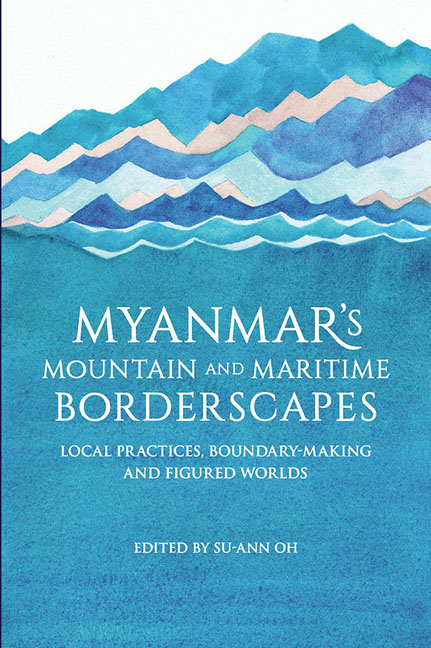Book contents
- Frontmatter
- Contents
- List of Tables
- List of Figures
- Acknowledgements
- Notes on Language, Terminology and Geographical Names
- Contributors
- Abbreviations
- 1 Introduction
- I Overview of Myanmar's Mountain and Maritime Borderscapes
- II Territorial Claims and Imagined Boundaries
- III Social Organization and Border Economies
- IV Mobile Practices and Moving Borders
- V Identity Construction and the Politics of Belonging
- VI Institutionalized Identity and Border Practices
- 15 The Chin State-Mizoram Border: Institutionalized Xenophobia for State Control
- 16 Tăi Buddhist Practices on the China-Myanmar Border
- Index
16 - Tăi Buddhist Practices on the China-Myanmar Border
from VI - Institutionalized Identity and Border Practices
Published online by Cambridge University Press: 06 June 2017
- Frontmatter
- Contents
- List of Tables
- List of Figures
- Acknowledgements
- Notes on Language, Terminology and Geographical Names
- Contributors
- Abbreviations
- 1 Introduction
- I Overview of Myanmar's Mountain and Maritime Borderscapes
- II Territorial Claims and Imagined Boundaries
- III Social Organization and Border Economies
- IV Mobile Practices and Moving Borders
- V Identity Construction and the Politics of Belonging
- VI Institutionalized Identity and Border Practices
- 15 The Chin State-Mizoram Border: Institutionalized Xenophobia for State Control
- 16 Tăi Buddhist Practices on the China-Myanmar Border
- Index
Summary
INTRODUCTION
This chapter explores the relationship between the local Buddhist practices of Tăi people who cross the border between China and Myanmar and the religious policy of the two countries, in which these movements are situated. It explores the question of how the monks and holu, experts in Buddhist rituals, migrate from Myanmar to revive their local religious practices after the Cultural Revolution in China. The next question is how the local people across the border perceive the Buddhist practices which originated from Myanmar. Answering these questions will shed light on the practices of the border area between China and Myanmar, and disclose an aspect of Myanmar Buddhism which is invisible from the viewpoint of national religious institutions.
The research field, Dehong Dai and Jingpo Autonomous Prefecture, Yunnan Province, China, is located on the China-Myanmar border (see Figure 16.1). One of the main groups in this area is the Tăi people. Han Chinese call them Dai, and the Burmese call them Shan. The Tăi people typically live in the basin valley areas, called məŋ in the Tăi language. The area where the research was conducted is called Məŋ Mau. After the end of the nineteenth century, the Qin Dynasty and British colonial rulers started the process of boundary demarcation. As a result, Məŋ Mau was divided, finding itself located in two countries — China and Myanmar. Nowadays, the Chinese side of Məŋ Mau is part of Ruili city, while the Myanmar side forms the Muse and Nanhkan townships (see Figure 16.2).
Most of the Tăi people follow Theravāda Buddhism. Theravāda Buddhists mainly live in mainland Southeast Asia and share a relatively homogeneous Pali canon. But their practice of precepts and the manner of rituals may differ a little. Groups sharing the same practices have developed into sects.
Historically, among lay Buddhists it was the kings — being the greatest donors and benefactors — who protected Buddhism. However, some kings also drove out monks who were regarded as heretics. These practices legitimized the Buddhist kings. Previous studies point out that the Sangha was institutionalized in each country during nation building, the objective of which was the standardization of Buddhist practices (Ishii 1986 (1975); Tambiah 1976, p. 240).
- Type
- Chapter
- Information
- Myanmar's Mountain and Maritime BorderscapesLocal Practices, Boundary-Making and Figured Worlds, pp. 369 - 388Publisher: ISEAS–Yusof Ishak InstitutePrint publication year: 2016

